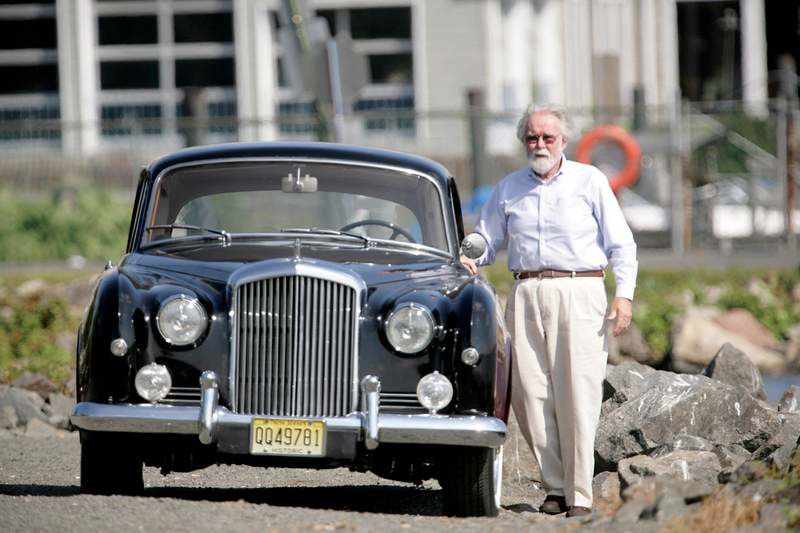Beginner’s luck led to Bentley love affair
Published 4:00 am Friday, November 13, 2009

- David Wilkinson bought his 1956 Bentley Continental Coupe at auction for $6,300 in 1971. He was the only bidder. “I looked around, and no one else was bidding,” he said. “Suddenly, I hear, 'Going once, going twice, sold!' I was bewildered.”
NYACK, N.Y. — For David Wilkinson, a marble and stone contractor whose products adorn some of the grandest lobbies in Manhattan (think Goldman Sachs and the Bank of America tower), owning a British car has always been fraught with compromise.
Many have come and gone.
Wilkinson, 75, recalled an Austin-Healey 3000. “That engine was incredible,” he said. “The car, of course, could torture you.”
Of a Jaguar XK 120M, he remarked, “God, that was a beautiful car — but it was painful to drive. It was built for a 5-foot-7, 162-pound Englishman.”
Which Wilkinson is not.
The one car that has remained in his garage and has satisfied all of his particular requirements — notably speed, beauty and interior space — is a 1956 Bentley S1 Continental Coupe he bought at auction in 1971 for $6,300, a price that now seems startlingly low. Call it beginner’s luck — it was Wilkinson’s first car auction.
His reason for attending had more to do with family history than with classic cars. The story goes back to the 1912 Indianapolis 500, where his mother’s uncle, Ralph DePalma, led nearly the entire race in a Mercedes-Benz known as the Grey Ghost.
“I had heard stories of him, and he was something of a legend in the family,” Wilkinson said recently, sharing a tray of olives and pale Marcona almonds at his home here.
Auto racing was still a new sport, and it was only the second running of the 500. Hours into the race, DePalma, an Italian raised in Brooklyn, held a comfortable lead when the engine of his Mercedes gave out.
“That would have crushed most men,” Eddie Rickenbacker, the World War I fighter ace and a fellow competitor that year, wrote in a 1945 Esquire magazine article. “But DePalma answered with a show of character that will be remembered as long as the concrete foundations of the Indianapolis speedway stand.”
What DePalma and his riding mechanic — there were two seats in the racecars back then — did was hop out and push the car more than a mile and a half to the finish line, to the roar of the 80,000 in attendance. DePalma was listed as finishing down in 11th place, but the picture of him pushing the Mercedes made newspapers around the world.
A lucky bid
Decades later, that gutsy feat led Wilkinson to the classic car auction near Philadelphia, where a Mercedes racecar from De- Palma’s era was being offered.
Wilkinson could not afford the Mercedes, but when the Bentley crossed the block he could not stop himself. “I raised my paddle,” he said.
He was the only one. “I looked around, and no one else was bidding,” he went on. “Suddenly, I hear, ‘Going once, going twice, sold!’ I was bewildered.”
As he should have been, considering the car’s attractions. Only about 400 S1 Continentals were made in 1955-59. Bentley was part of Rolls-Royce at the time, and there wasn’t much difference between the S1 Continental and the Rolls-Royce Silver Cloud of the era (a car that had a star turn in the famous Grey Poupon commercial).
Wilkinson’s car has the added distinction of having its steering wheel on the left side. “Only 31 were ever built,” he said quietly. He estimates the car to be worth $200,000 to $300,000.
A big car
Everything about the car — the tires, the grille — is big. The hood stretches nearly half the length of the car to contain its engine, a 4.9-liter in-line 6, which came with about 150 horsepower.
When Wilkinson bought the Bentley, it was in good mechanical shape, he said, but the interior needed a thorough restoration. Over the years, he sent the wood dashboard and trim, which had water damage (there was a leaky windshield), to specialists in Missouri. He later installed air conditioning and a cassette deck. More recently, he had the leather seats reupholstered.
Until 10 years ago, he drove the Bentley regularly. These days, it spends most of its time in his garage, a tight fit.
Wilkinson has more than a slight resemblance to the director Richard Attenborough. Sitting on the back porch of his home near the Hudson River, which can be seen through the trees, Wilkinson said the house had once belonged to a chauffeur.
A driving force
There are more examples of how cars have been a big part of Wilkinson’s life. He spent his teenage years in Southern California, where he drag-raced on airstrips. “My formative years,” he reflected with a slow smirk. “First time I discovered women, alcohol, cars — all the good things.”
A cruise around the quiet town that afternoon brought Wilkinson past a vacant brick building that once housed a notable dealership, the Vintage Car Store, owned by the late Ed Jurist.
“A fascinating man,” Wilkinson said. “He’s the reason I live in Nyack.”
In the early 1980s, Wilkinson was a Manhattanite looking to escape what he called “a dirty city.” He looked at all of the “socially acceptable” suburbs but found them unsuitable. He didn’t feel comfortable living among “those fine folk,” he said. “I’m not sure how well I’d do in their country clubs.”
Then he heard about Nyack, which he characterized as “kind of ragged” in those days. “Not like it had been in the ’60s,” Wilkinson said, “but it was considerably not there yet. When you figure I bought this place for $70,000, that tells you where Nyack was then.”
Then he came across Jurist’s store — cars! — and went in. “Of course, he knew my mother’s uncle first-hand,” Wilkinson said. “He’d known him.”
And that settled the matter.






